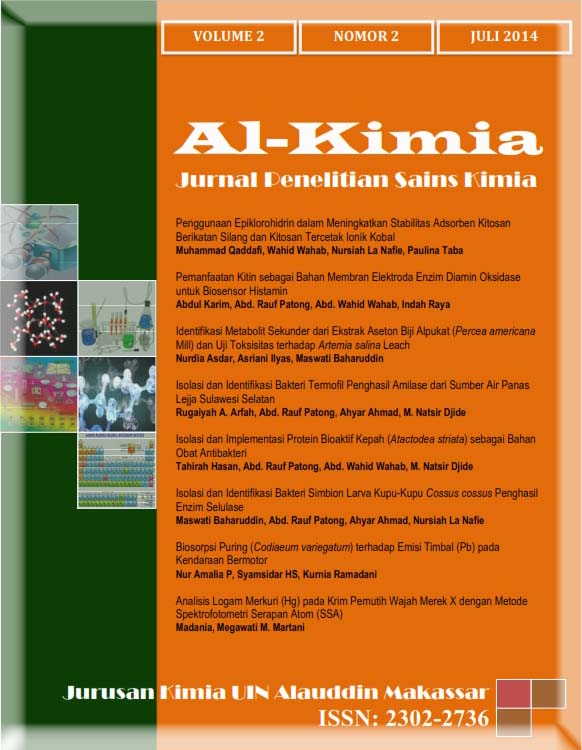Analisis Logam Merkuri (Hg) Pada Krim Pemutih Wajah Merek X Dengan Metode Spektrofotometri Serapan Atom (SSA)
Abstract
Whitening creams that supposedly contain mercury which is added with the aim to reduce freckles on the skin’s surface, but it gives a negative impact, for it was conducted analysis of the presence of mercury compounds qualitatively and quantitatively. This research is purely experimental research with the aim of identifying the content of mercury (Hg) is the bleach cream face on brand X circulating in Indonesia are on the label does not have the composition, number and batch number POM and determine levels of mercury (Hg) is the bleach cream face on brand X. Qualitative test using three reagents that NaOH, HCl, KI whereas quantitative testing using atomic absorption spectrophotometry (SSA).The result of the research that brand X contains mercury (Hg). Brand X code A contains 2718,1273 bpm mercury (Hg) and code B contains 214,1661 bpm. Quantitative analysis results calculates using concentration obtained from a linear regression of whitening face cream brand X Code A contains 3239.9117 bpm mercury (Hg) and Code B contains 858,6798 bpm mercury (Hg) in pot.
Downloads
References
Anief, M., 2000, Ilmu Meracik Obat Teori dan Praktek, Yogyakarta: Universitas Gajah Mada Press.
Anonim, 1979, Farmakope Indonesia, Edisi III, Jakarta: Departemen Kesehatan Republik Indonesia.
Anonim, 2009, Batas Maksimum Cemaran Logam Berat dalam Pangan, Jakarta: Badan Standarisasi Nasional Indonesia (BSNI).
Anonim, 2006,Analisa Merkuri secara Spektrofotometri Serapan Atom Tanpa Nyala, Jakarta: Balai Besar Pengembangan dan Pengendalian Hasil Perikanan (BBP2HP).
Arisworo, D., 2007, Ipa Terpadu, Bandung: Grafindo Media Pratama
Dahuri, R., 1996, Bahaya Logam Berat dalam Makanan, Jakarta: Pradnya Paramita
Darmono,1995, Logam Dalam Sistem Biologi Mahkluk Hidup, Jakarta: Universitas Indonesia Press.
Dewi. 2011, Analisis Cemaran Logam Timbal (Pb), Tembaga (Cu) dan Kadmium (Cd) dalam Tepung Gandum secara Spektofotometri Serapan Atom, Skripsi, Depok:Universitas Indonesia.
Haris, Abdul dan Gunawan, 1992,Prinsip Dasar Spektrofotometri Atom.
Semarang : Badan Pengelola MIPA-UNDIP.
Iswari, 2007, Ilmu Pengetahuan Kosmetik, Jakarta: PT Gramedia Pustaka Utama.
Joenoes, N., 1990, Resep yang Rasional, Surabaya: Universitas Airlangga Press Kepala Badan Pengawas Obat dan Makanan Republik Indonesia. Peraturan Kepala Badan Pengawas Obat dan Makanan Republik Indonesia.
Nomor Hk.03.1.23.07.11.6662 Tahun 2011 Tentang Persyaratan
Cemaran Mikroba dan Logam Berat dalam Kosmetika.
Khopkar, S. M., 2002, Konsep Dasar Kimia Analitik. Jakarta:Universitas Indonesia Press.
Malahayati, 2010, Solusi Murah Untuk Cantik Sehat Energik, Yogyakarta: Great Publisher.
Olivia, F., 2008, Gaya Hidup Penghambat Alzheimer. Jakarta : PT Elex Media Komputindo.
Oxtoby, 2001, Prinsip-Prinsip Kimia Modern, Edisi ke-4, Jilid 1, Jakarta : Erlangga.
Palar, H., 1994, Pencemaran dan Toksikologi Logam Berat, Jakarta: PT Rineka Cipta.
Parengkuan, Kissi, Fatimawali, Citraningtiyas, Gayatri, 2013, Analisis Kandungan Merkuri pada Krim Pemutih yang Beredar Di Kota Manado, Jurnal Ilmiah Farmasi, Manado : Universitas Samratulangi.
Putriyanti, Dian, Nainggolan, Radja, Pratistha, Agni, 2009, 100% Cantik, Jakarta : Penerbit Best Publisher Jin.
Rieger, M., 2000, Harry's Cosmeticology, 8th Edition, New York : Chemical Publishing. Co., Inc.
Syafnir, L., dan Putri, A., 2011, Pengujian Kandungan Merkuri dalam Sediaan Kosmetik dengan Metode Spektrofotometri Serapan Atom.Prosiding Seminar Nasional Penelitian dan PKM Sains, Tekhnologi dan Kesehatan. Bandung: ISSN:2089-3582 Universitas Islam Bandung.
Tranggono, R., dan Latifah, F., 2007, Ilmu Pengetahuan Kosmetik, Jakarta: PT Gramedia Pustaka Utama.
Wasitaatmadja, S., 1997, Penuntun Ilmu Kosmetik Medik, Jakarta: Universitas Indonesia Press.
Authors who publish with this journal agree to the following terms:
1) Authors retain copyright and grant the journal right of first publication with the work simultaneously licensed under a Creative Commons Attribution License that allows others to share the work with an acknowledgement of the work's authorship and initial publication in this journal.
2) Authors are able to enter into separate, additional contractual arrangements for the non-exclusive distribution of the journal's published version of the work (e.g., post it to an institutional repository or publish it in a book), with an acknowledgement of its initial publication in this journal.
3)Authors are permitted and encouraged to post their work online (e.g., in institutional repositories or on their website) prior to and during the submission process, as it can lead to productive exchanges, as well as earlier and greater citation of published work (See The Effect of Open Access).


